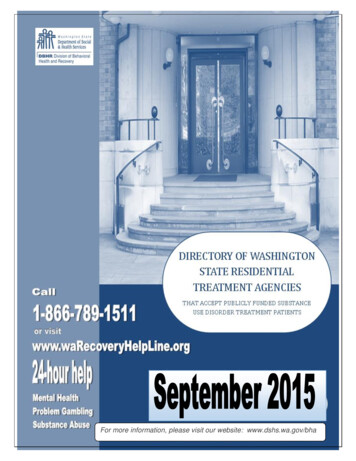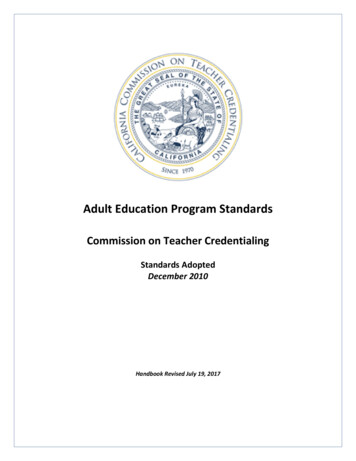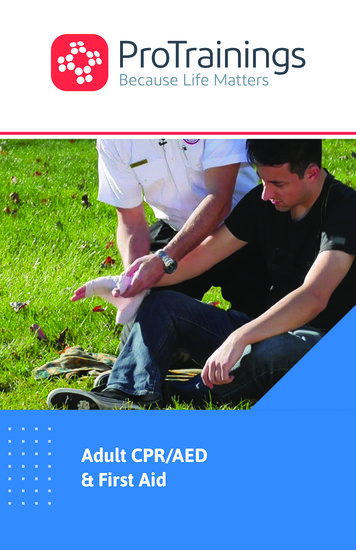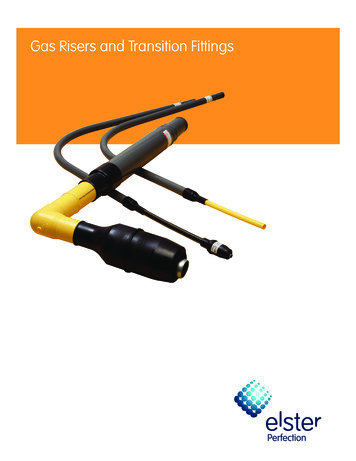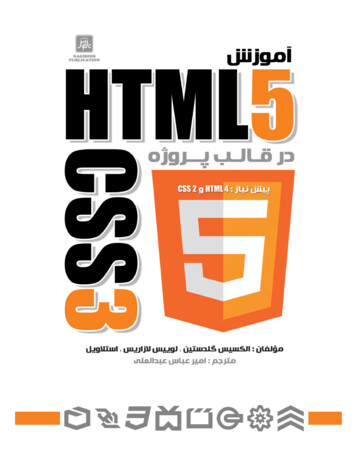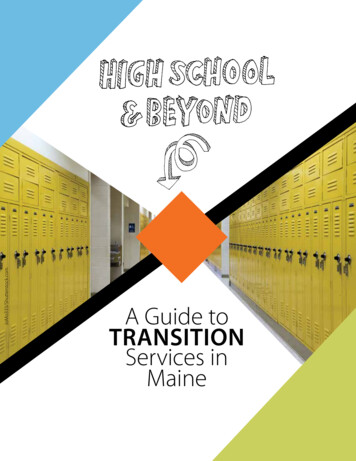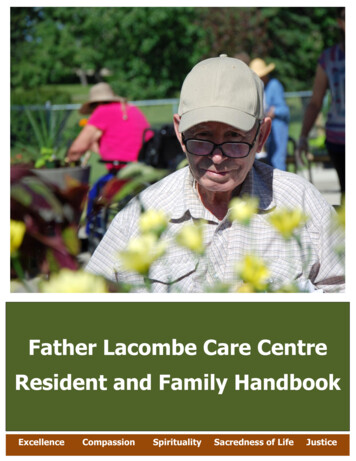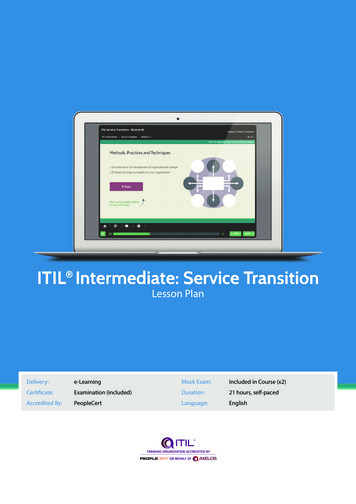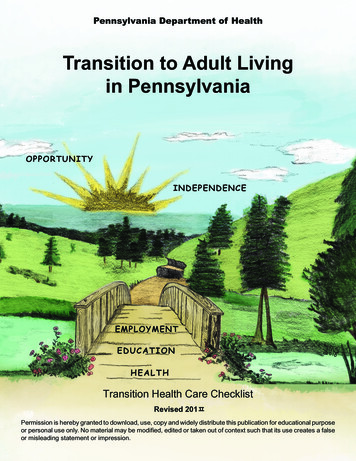
Transcription
Pennsylvania Department of HealthTransition to Adult Livingin PennsylvaniaOPPORTUNITYINDEPENDENCEEMPLOYMENTED U C ATIONHEALTHTransition Health Care ChecklistRevised 201 Permission is hereby granted to download, use, copy and widely distribute this publication for educational purposeor personal use only. No material may be modified, edited or taken out of context such that its use creates a falseor misleading statement or impression.
Pennsylvania Department of HealthThis publication is available online. Please visit the Pa. Department of Health thttp://www.gotoskn.state.pa.usConcern:Youth are leaving school and discovering they have no health insurance or doctor and are having difficulty obtainingmedications and treatments.There were 13.7 million uninsured youngadults, ages 19-29, in the US, in 2006.Source: Analysis of the March 2007 Current Population Surveyby S. Glied and B. Mahato for The Commonwealth FundLacking health insurance threatens young adults’ access to care in the US.Source: The Commonwealth Fund Biennial Health Insurance Survey (2007) [unpublished]Goal:To provide a checklist, resources and steps to assist youth and families in making a successful transition to adultliving that includes health and health care.Disparity:People with disabilities are truly a minority population with disparities in obtaining health care due to issues ofaccess, provider availability, income, discrimination and communication.The number of unemployed persons in Pa. with a disability in 2005 was 54,000:Source: vania/Within Pennsylvania, there were 317,835 persons withdisabilities receiving Supplemental Security Income.Among these persons, [only] 16,945 (5.3 percent)reported earned income from employment during theprior year. (SSA, December 2008)We welcome this document to be a springboard to future endeavors or documents. If you wouldlike to partner, please contact the Pa. Community on Transition State Leadership Team.e-mail: transitionchecklist@pattanpgh.net
Transition to Adult Livingin PennsylvaniaTransition Health Care ChecklistTable of Contents1Transition Planning in the Educational System2Introduction to Transition Skills Inventory3Accept Yourself: Who Am I?9Declare Yourself: Who I Am13Empower Yourself: I Am!18Transition Quick-Reference Resource Guide19Pennsylvania Youth Leadership NetworkAppendices20Appendix AHealth Insurance Options21Appendix ATips to Maintain Health Insurance22Appendix BTransition Timeline23Appendix CFinancial and Legal Concerns24Appendix CFinancial and Legal Concerns - Special Needs Trust25Appendix DHIPAA/COBRA26Appendix ESocial Security Administration (SSA)29Appendix FCenter for Independent Living (CIL)31Appendix GMedical Assistance (Medicaid)/MAWD/CHIP34Appendix HMedicaid Funded Waivers (also called Home and Community Based Services(HCBS)36Appendix ISpecial Health Care Programs37Appendix JOffice of Developmental Programs (ODP)39Appendix KMental Health (MH)40Appendix LChildren, Youth and Families (CYF)41Appendix MOffice of Vocational Rehabilitation (OVR)42Appendix NAssistive Technology (AT)43Appendix OMedical Homes44Acknowledgements
Transition Planning in the Educational SystemWhere do I begin?What happens next?Secondary Transition is the process of preparingTransition planning involves a partnership betweenyouth for life after high school. Transition planning inthe youth, their family, educational staff, school-agePennsylvania is legally required in the Individualizedservices, post-school services, program providersEducation Program (IEP) by age 14; however,and local community members that results in higherthoughtful transition planning can begin at any age.education, employment and independent living.In a youth’s high school program, there are threeTransition should be viewed as a bridge betweenmain post-secondary goals that must be addressed:school programs and the opportunities of adult life.post-secondary education or training, employmentThe Secondary Transition Process entails ongoingand independent living. These three areas are theassessment that results in the youth’s understandingdriving force behind the IEP written for students inof current strengths, interests, preferences, needs andhigh school. Transition planning continues throughplanning for services and supports needed to achievehigh school as instruction and community experiencesfuture success. This Transition Skills Inventory (pagessupport these postsecondary goals. By beginning to2-18) should be used as part of the transition planningdiscuss transition as early as possible, the IEP teamprocess to ensure that a youth’s healthcare needs arecan work with each youth and their family to plan forrecognized and incorporated into the plan.the future. This includes selecting classes, activities,What type of servicesare available?and services that will be meaningful and motivatingto the youth and lead to his/her postsecondary goals.To assist youth and families in this process theThe PDE, through the BSE and local school districts,Pennsylvania Department of Education (PDE), Bureauoffers a variety of supports to students, parents andof Special Education (BSE) and the Pennsylvaniafamily members to ensure a successful transitionTraining and Technical Assistance Network (PaTTAN)to post-secondary life. These supports includeprovide to all 14 year-old students with an IEP a copyspecial education teachers, transition coordinators,of Pennsylvania’s Secondary Resource Folder andrehabilitation counselors, guidance counselors andCD. This information can be obtained through yourschool health programs. Regionally throughoutschool district, by visiting the PaTTAN website atPennsylvania, there are 29 Intermediate Units (IU),www.pattan.net (found in the section for secondaryeach with at least one designated transitiontransition under publications) or by callingcoordinator. Information regarding Pennsylvania’s1-800-360-7282. Throughout the planning process, it isIntermediate Units can be found on the PDEimportant to remember that, once a student graduateswebsite at www.pde.state.pa.us. The PaTTANfrom high school or reaches age 21, she/he is noworks collaboratively with local school districtslonger entitled to services through the educationaland Intermediate Units to provide professionalsystem. A youth must apply and meet eligibilitydevelopment, technical assistance and informationrequirements for services provided by adult agencies.regarding transition projects, products and activitiesthat promote successful outcomes for transitioningyouth. More detailed information on supports andservices provided by PaTTAN can be foundat www.pattan.net.1
Transition Skills Inventory”How does the individual’s health impact the transition activity?”The hope is that skills can be taught and learned. If a particular skill cannot be achievedfor independence, a plan is then developed.Do you know? Youth at age 18: Are legally adults and can sign healthcare documents;Need to have their own legal signature;Need to give permission for family members to talk withhospitals, schools, police departments and othercommunity agencies; andNeed to understand that services change fromentitlement to eligibility.Introduction to the Transition Skills Inventory Know when transition begins. Ideally speaking, transition begins at the time of identification. It represents aprocess as opposed to an event. Learn cutural differences and practices. Culture is a shared way of life passed on from generation togeneration. It includes what people think and what people do, value and believe. In working acrossmulti-cultural communities, practitioners and providers need to be aware of cultural differences and practices. Review transition goals for post-secondary, employment and independent living. Identify current and expected future healthcare and medical needs. Work through the Transition Skills Inventory to determine what the individual can do now, what needsto be learned and what supports may be needed. Make a comprehensive transition plan:-- Have current assessment information from youth, family, doctors and therapists.-- Know current functioning level at home, school, and in real life situations.-- Set goals and write these into all your plans with schools, agencies and doctors.-- Are you receiving the help you need? See Resources throughout document.-- Identify individuals who family and youth can invite to assist with transition planning, to include: General education teacher, school nurse, doctor, therapists, mental health/intellectual disabilities, Officeof Vocational Rehabilitation, Social Security Administration, County Assistance Office, Children, Youth &Families, case managers and/or local advocates. Continue to use this inventory at key transition times and adjust the plan according to the changingneeds of the individual in transition.Pennsylvania Youth Leadership Network (PYLN) has been the source of inspiration for thechanges to this document. We thank the PYLN for their permission to use their words and ideasfrom the Pennsylvania Youth Leadership Secondary Transition Toolkit.2
ACCEPT YOURSELF: WHO AM I?SELF-AWARENESSCan GoNeedsDlready SracticeCan describe likes DQG dislikesKnow name, birthdate, address, telephone number, etc.Know height DQG weightKnow when DQG how to ask for helpCan describe needed accommodationsKnow present medical conditions/allergiesCan describe disabilityPlanning for the future: AccommodationsWho & ZhereIncludedin Slan
ACCEPT YOURSELF: WHO AM I?SAFETYCan GoNeedsDlready SUacticePERSONAL SAFETYCarry appropriate personal ID when leaving homeUnderstand who can helpKnow how to avoid dangerous situation(s)Understand who is allowed to have personal informationKnow when and how to dial 911Have emergency plan for fire, medical or disasterUnderstand proper use of matches/lighters/chemicalsHas and maintains fire extinguisher DQG smoke detectorCan respond appropriately to fire alarm (exits, meeting places)Understand abuse: physical, emotional, sexual, financial, legalUnderstand 'stranger danger' (including internet safety)Know where Social Security card DQG birth certificate are; when to useAble to problem solve for unexpected situationsPlanning for the future: AccommodationsWho & ZhereIncludedin Slan
ACCEPT YOURSELF: WHO AM I?SAFETYcontinuedCan GoNeedsDlready SracticeHEALTH SAFETYKnow signs and symptoms of personal health emergenciesKnow contact information for healthcare providersCan treat minor cuts, scrapes, burnsAvoid tobacco, alcohol DQG drugsENVIRONMENTAL SAFETYUnderstand dangers of hot DQG coldKnow how to use household chemicals properly (do not mix)Know how to protect themselves by wearing gloves, safety glassesCan read DQG understand labels or know who to ask for helpPlanning for the future: AccommodationsWho & ZhereIncludedin Slan
ACCEPT YOURSELF: WHO AM I?COMMUNICATIONCan GoNeedsDlready SracticeKNOW COMMUNICATION METHODSVerbal: how well understood by othersSigns/lip reading: know how to arrange for interpretersDevices: know how to care for, get routine maintenance, use independentlyWritten: has basic writing skills necessary to provide name, whereabouts, etc.Non-verbal: has support person available who is familiar with individual’smethods of communicationKnow when, why DQG how to sign nameKnow how to communicate by phone/TTY/TTDPlanning for the future: AccommodationsWho & ZhereIncludedin Slan
ACCEPT YOURSELF: WHO AM I?HEARING & VISIONCan GoNeedsDlready SracticeKnow who provides service DQG how/when to get equipment repairedUse hearing devices independentlyGet hearing checked, get optionsGet eye exam, get glasses/contactsKnow who provides service DQG how/when to get a new prescriptionAsk for accommodations for vision/hearing (as needed)Has had comprehensive visual and auditory processing evaluation(s)Planning for the future: AccommodationsWho & ZhereIncludedin Slan
ACCEPT YOURSELF: WHO AM I?MEDICATIONCan GoNeedsDlready SracticeKnow why, when DQG how often to take medicationRecognize medication appearance (size, color, consistHncy)and question differencesKnow how medications are to be taken (oral, sub-lingual, rectal, vaginal,topical, eye/ear drops, ointments, inhalents, injections)Know never to share medicationKnow who to call with questions or to get helpCan open “child resistant” caps or can ask for bottles that can be openedCan fill daily/weekly pillboxKnow when and who to call for prescription refillsKnow how to purchase and properly use over-the-counter medication (OTC)Know medication(s): name, purpose side effects and restrictionsUnderstand OTC, herbal or alternative remedies and how they interactwith prescriptionTalk to MD or pharmacist when having difficulty getting medications paid for(may have information on prescription assistance programs or exception forms)Planning for the future: AccommodationsWho & ZhereIncludedin Slan
DECLARE YOURSELF: WHO I AMSELF-ADVOCACYCan GoNeedsDlready SracticeKnow how to ask for accomodationsKnow about disability card (www.arcindiana.org/IAMD.pdf)Understand disability rights lawsKnow when to speak upKnow how to make contact with community advocacy organizationsKnow when to disclose information (GOOGLE: “411 Disclosure”)Planning for the future: AccommodationsWho & ZhereIncludedin Slan
DECLARE YOURSELF: WHO I AMMONEY MANAGEMENTCan GoNeedsDlready SracticeUnderstand use and need for moneyUnderstand values of U.S. coins DQG paper moneyKnow source(s) of moneyUnderstand difference between wants DQG needsUnderstand appropriate use of cash, check, debit cardUnderstand responsible use of credit cards DQG loansCan develop a household budget (food, utilities)Understand how to pay billsUnderstand contracts (door-to-door sales)Planning for the future:10AccommodationsWho & ZhereIncludedin Slan
DECLARE YOURSELF: WHO I AMPOST-SECONDARY CONSIDERATIONSCan GoNeedsDlready SracticeKnow career/employment goals DQG related education optionsKnow who can help with transition planning(transition coordinators at IU; PaTTAN)Know funding sources for educational DQG training optionsHave considered pros DQG cons of full-time DQG part-time enrollment;effect on benefitsHave developed a plan to explore DQG evaluate career goals; possibleeducation optionsAble to discuss conditions that require individualized accommodationsKnow rights and responsibilities under ADA DQG 504 Rehabilitation Act lawsHave toured schools DQG visited with the office for students with disabilitiesKnow how to work with the Office of Vocational Rehabilitation (OVR)Have worked with health services to plan for medical emergenciesPlanning for the future:11AccommodationsWho & ZhereIncludedin Slan
DECLARE YOURSELF: WHO I AMEMPLOYMENT CONSIDERATIONSCan GoNeedsDlready SracticeUnderstand value DQG benefits of being employedExplore DQG discuss what type of employment is desiredKnow funding sources for employment optionsUnderstand how health concerns impact various career optionsDescribe employability skillsIs able to discuss with employer the conditions that require individualizedaccommodationsConsider pros DQG cons of full-time DQG part-time workUnderstand how to get to/from work; have good transportation planUnderstand employee benefitsKnow how to work with Office of Vocational Rehabilitation (OVR)Know if work place has people trained for medical emergenciesuntil 911 arrivesHas emergency form completed; form given to appropriate peoplePlanning for the future:12AccommodationsWho & ZhereIncludedin Slan
EMPOWER YOURSELF: I AM!COMMUNITY LIVINGCan GoNeedsDlready SracticeLIVING ARRANGEMENTSAware of options of where to liveAble to evaluate living arrangements for accessibility to healthcare providersAware of living expenses DQG how to pay for themAware of need(s) for supportsAware of how to pay DQG maintain supportsTRANSPORTATIONAble to safely get around in the communityAware of equipment DQG adaptations neededAware of how to apply for para-transit servicesAble to use appropriate transportation to get to work, medical appointments DQGcommunity activitiesAware of who can provide transportation DQG able to make arrangementsAware of how to apply for PennDOT's accessible parking placardAware of how to obtain driver's license DQG related support servicesAware of funding or saving money for vehicle; needed adaptations;maintenance DQG related expensesPlanning for the future:13AccommodationsWho & ZhereIncludedin Slan
EMPOWER YOURSELF: I AM!COMMUNITY LIVINGcontinuedCan GoNeedsDlready SracticeSOCIAL RELATIONSHIPSAware of opportunities to make friends and meet new peopleAware of peope to trust DQG ask for adviceRespectful of other's personal space DQG propertyAware of the guidelines for dating DQG healthy relationshipsAware of safe sexual practices DQG options for individual choicesEMERGENCY PLANNINGAware of potential emergenciesHave a portable crisis kit packed and availableHave back-up plans and people for all eventsThink about what is needed to travel locally IRU vacationPractice a drillBecome involved in local planningPlanning for the future:14AccommodationsWho & ZhereIncludedin Slan
EMPOWER YOURSELF: I AM!MEDICAL MANAGEMENTCan GoNeedsDlready SracticeINSURANCE & BENEFITSAware of need to take all insurance cards to all appointmentsAble to use insurance cards appropriatelyAble to understand what services are covered by insuranceAble to pay co-pay DQG out-of-pocket expenses as necessaryAble to identify approved providers under insurance planAware of insurance plan's special needs unit or case managerAware of pre-approval and pre-certification rulesMANAGE MEDICAL INFORMATION & RECORD-KEEPINGAble to follow instructions from healthcare providersAble to fill out medical forms or ask for assistanceAble to maintain a system for keeping medical records(binder or file, electronic folder)Able to compile medical tests DQG results/summaries/functional assessmentPERSONAL CARE ATTENDANTS, EQUIPMENT & TREATMENTSAble to evaluate need for personal care attendants, equipment DQG treatmentsAware of need for physician orders DQG insurance approvalAble to manage personal care attendant servicesAble to understand DQG use remedial/prosthetic devices DQG equipmentas prescribedAble to arrange for equipment maintenance (routine DQG emergency)Aware of who provides treatments DQG therapiesAble to follow instructions for treatments DQG therapiesAble to schedule DQG attend all treatments DQG therapiesMedical Management continued on next page.15AccommodationsWho & ZhereIncludedin Slan
EMPOWER YOURSELF: I AM!MEDICAL MANAGEMENTcontinuedCan GoNeedsDlready SUacticeTRANSITION TO ADULT HEALTHCARE PROVIDERSAble to respond to questions from healthcare providersAble to prepare questions for healthcare providersAware of confidentiality DQG need to sign HIPAA formsAware of differences between primary care providers DQG specialistsAware of benefits of interviewing prospective healthcare providersAble to evaluate accessibility of office DQG exam roomsAble to make appointments for specialists, family planning, geneticcounseling, hospital DQG laboratory testsAble to call for referrals (as needed)Aware of Medical Home modelPlanning for the future:16AccommodationsWho & ZhereIncludedin Slan
EMPOWER YOURSELF: I AM!ACTIVITIES OF DAILY LIVINGCan GoNeedsDlready SUacticeUNDERSTANDING HOW TO ESTABLISH DAILY ROUTINEGet enough sleepEat a healthy dietExercise DQG get enough fresh airManage stressMAINTAIN GOOD HYGIENE ROUTINEBathe, wash hands and keep cleanWear clean clothesBrush teethWear deodorantTIME MANAGEMENTUnderstand passage of timeHas basic ability to keep track of timeKeep calendar of appointments DQG important eventsInclude time for hobbies DQG social activitiesWELLNESSParticipate in physical activity (with modifications as needed)Understand and deal safely with food allergiesUnderstand specialized diet needs, foods, medical follow-upFollow routine health care:doctor visits, breast DQG testicular self-exams, pap test, prostate healthKeep immunizations current DQG records easily accessibleUnderstand sexual awareness to prevent pregnancy, STD's DQG HIV/AIDSPlanning for the future:17AccommodationsWho & ZhereIncludedin Slan
IAMD.pdfAssistive .jan.wvu.eduwww.patf.usGeneral Transition Siteswww.sharedwork.orgTRANSITION QUICK-REFERENCE RESOURCE GUIDEAre you receiving the help that you need?Here are some additional resources to look into.POST-SECONDARYEDUCATION & TRAINING(Community .aspwww.ncwd-youth.infoIndependent pa.us(Office of Vocational Rehabilitation)KWWS SFLO QHW SDJHV FLOV ORFDWHBDBFLO DVS[ Preparing for Career andTechnical SI and SSDI WorkIncentiveswww.autismhandbook.orgAdditional omKWWS QLFKF\ RUJ huneinc.orgwww.gottransition.orgCareer Interest andOccupational Informationwww.paddc.orgEmergency .ready.govwww.serv.pa.govPA Youth Leadership Network Toolkitswww.pyln.org/health/toolkitsPOISON CONTROL: fits and 12Casey Life Skills Assessments (Caregiver & Youth):www.casey.org/resources/tools/cls/18Health and bilitiesINDEPENDENTLIVINGPreparing for aEMPLOYMENTRecreation and .orgwww.kidsource.com
PA Youth Leadership NetworkResourcesWhat is the Pennsylvania Youth Leadership Network (PYLN)?The PYLN is a team of youth leaders with disabilities from acrossPennsylvania with a purpose to develop the self-determination,empowerment, and leadership of youth that promotes successful postschool outcomes in the areas of education, employment, independentliving, and health and wellness among youth and young adults throughoutPennsylvania.Developed BYYouth FOR Youth!Goals of the PYLN Provide a youth voice at the tableon important boards andcommittees that impact the lives ofyouth with disabilities.Recruit and match mentors whoare young adults with high schoolyouth to help them prepare fortheir future success.Develop and share transition, selfdetermination, self-advocacy, andempowerment resources gearedtoward youth in high school.Ensure unbiased policies, practicesand attitudes that affectindividuals with disabilities Pennsylvania Youth Leadership NetworkSecondary Transition Toolkit PYLN Health Care ToolkitAs a follow up to the 2008 PennsylvaniaYouth Leadership Network’s (PYLN)Secondary Transition Toolkit the PYLN, withfunding support from a Heinz EndowmentYouth Philanthropy grant, has created thePYLN Health Care Toolkit. With a focus onliving a fulfilled healthy life, The PYLN HealthCare Toolkit is designed to further assist youthin their transition into the adult world. Thebest thing about the toolkit is that it was writtenand designed by youth with disabilities whoare members of the Pennsylvania YouthLeadership Network (PYLN) for youth. It canalso be used with families and professionalsas a youth-friendly resource for transition.The PYLN Wants to Connectwith YOU! Connect to the PYLN by visiting ourwebsite: http://www.pyln.org This URL address will connect you toinformational videos, materials andupdates regarding the PYLN.Youth driven, youth written tool for youth110 page guide and workbook for the transition processAccessibleDivided into three phases– Phase One: ACCEPT YOURSELF!– Phase Two : DECLARE YOURSELF!– Phase Three : EMPOWER YOURSELF!19
Appendix A: Health Insurance OptionslIf you are 18 years old and have:- No Medical Assistance (MA)- No Medical Assistance forChildren with Special Needs- No private insurance- MA with SSI- MA for Childrenwith SpecialNeedsChildren’s HealthInsurance Program (CHIP)will end the month of your19th birthdayPrivate insurancePatient Protection andAffordable Care Act (ACA)-Then:- Apply for MA programs including MAfor Workers with Disabilities (MAWD)- Apply for CHIP- Obtain private health insurance- College-apply for student plan- Apply for SSI (Adult Criteria)- MA may continue*- Apply for MA programs including MAfor Workers with Disabilities (MAWD)- Explore private insurance options- Visit www.pahealthoptions.com- Student status or coverage as adultdisabled dependent child- Check HIPAA Portability and conversionpolicies (group to self plan)- Group plan through employer(may include HIPP**)- Opt for COBRAParent’s group plan up to 26th birthdayNo denial or premium penalty for pre-existing conditionsNo lifetime limits for coverageCall “high-risk pool” PA Fair Care (888-767-7015)Check out www.pafaircare.com or www.healthcare.govfor more information* You may lose Medical Assistance if you do not meet SSI adult disability criteria.** Health Insurance Premium Payment (HIPP)-A Medical Assistance Program that will pay your premium for insurance plan at work if you qualify.20
Appendix A: Tips to Maintain Health InsuranceYouth may be able to continue on their family’s private insurance plan as long as they are considered an “adultdisabled dependent child”, are in school/college or qualify under the provisions of the ACA. Ask Human Resources or insurance company for information/application. This information should include theprocess and form for the doctor to complete. Include all medical conditions. This may be available as the youth leaves high school.Adult Disabled Dependent Child - Depending on company and policy May continue on family plan if dependent for life Be on family plan prior to turning 18 Annual re-certification - disability and dependentStudent status - Depending on company and policy Proof of college class load each semester (often requires full-time status) Ages 18 - 22, sometimes older Annual re-certificationCoverage up to 26th birthday - Depending on company and policyThe Health Insurance Portability and Accountability Act (HIPAA) - stands also for portability When changing group health insurance, get a certificate of coverage for portability. This will waive the waiting time and any increased costs for pre-existing conditions. You can contact your health insurance plan for more information about how the certificateof coverage will apply to your specific situation.Social Security as an adult is one pathway to public insurance (Medical Assistance).Youth receiving Social Security Disability Benefits (SSDI) as a child will need to reapply as an adult with disabilities.Youth may want to apply for Medical Assistance for Workers with Disabilities (MAWD).It is critical to have current evaluations and assessments, including educational, medical and psychological.These are needed to apply and qualify for many services and programs.Remember to return to the doctor for prescriptions and referrals for testing and services paid by public andprivate insurance.Depending on whether private or public insurance is used as primary, explore the type and level of servicesavailable. Check if covered services meet the needs of the youth.Be sure to show all service providers all insurance cards.Keep updated on National Healthcare Reform Law (www.whitehouse.gov/healthreform).REMEMBER: at certain ages, services and benefits change from entitlement to eligibility.21
Appendix B: Transition Timeline.Age 18Age 21Transition Services mustbe included as part of theIEP.A youth has the rightto make decisionsabout health care andfinances OR evaluate andconsider other decisionmaking options thatneed to be investigated(Power of Attorney and/orGuardianship).This is the last year theyouth is entitled to specialeducation servicesthrough Pa. Departmentof Education (PDE).Begin to considerinterests and preferencesthat can be connectedwith the education andmedical plans.Youth have the right to bepart of the IEP transitionteam.A youth may choose notto continue in school. Aparent may override thisdecision until age 21.Review attachedappendices to determineeligibility for services andwhen to apply.Start thinking and talkingabout transition frompediatric to adult healthcare providers.Transition to adult healthcare providers should bein progress.Transition to adult healthcare providers should becomplete unless specialprovisions are made.Prepare StandbyGuardianship (appropriatefor all children less than18 years).Begin to updateevaluations andassessments,including medical andpsychological, at age 16.Apply for SSI and reapplyfor MA programs.When a youth reachesage 21 and continues tobe MA eligible, limits areapplied to certain MAbenefits.Mental Health: At age14 and older, either theparent or the minor hasthe power to admit theminor to inpatient oroutpatient care.Contact private insurancecompany about continuedcoverage.Before Age 14Age 14If determined appropriateby the IEP team, transitionservices may be includedin the IEP.Males need to register forselective service.A youth can register tovote.Continue the development of social skills and interests in communityand recreation
Apr 04, 2013 · There were 13.7 million uninsured young adults, ages 19-29, in the US, in 2006. . 18 Transition Quick-Reference Resource Guide 19 Pennsylvania Youth Leadership Network Transition to Adult
